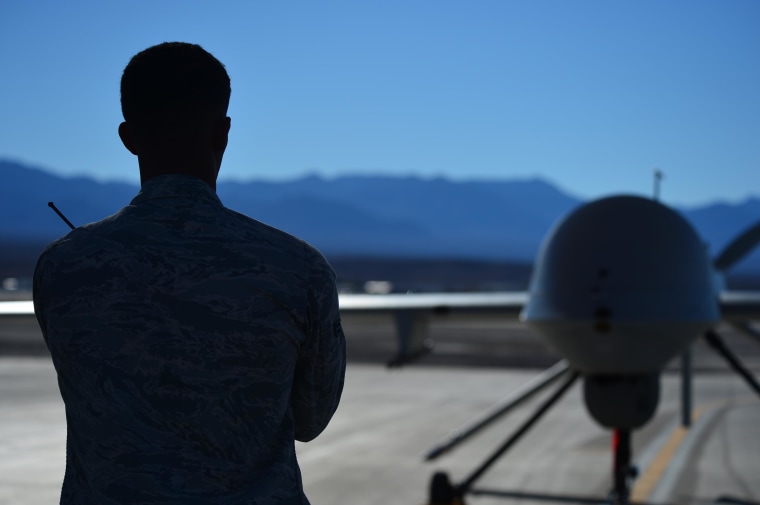A new report from the Government Accountability Office says the U.S. Air Force's remotely piloted aircraft program is understaffed, and the military branch isn't sufficiently supporting the officers who’ve signed up to fly the fleet of Predators and Reapers, which are used for reconnaissance and surveillance and sometimes for missile strikes.
Today’s Air Force drone pilots are overworked and stressed. They guide the unmanned aircraft over places like Afghanistan from bases thousands of miles away in Nevada, New Mexico and California. At the end of their long, pressure-filled shifts, when they drive home to their families, they may have missed a birthday or soccer practice. Some aren't sure when their deployment will end. And they sure can't talk about work.
“There’s been an explosion of the use of these particular vehicles,” said Brenda Farrell, the GAO's director of defense capabilities and management, who led the study. Yet, as of last December, the USAF employed 1,366 drone pilots — only 85 percent of the total needed to operate the 65 combat air patrols (each consisting of up to 4 drones) it intends to have in place by May.
Besides falling short on staffing, according to the report, the USAF hasn’t worked out how many people are needed to fly one operation. Also, it hasn’t fully investigated and made support arrangements for the effects that being deployed on base has on the mental health of the remote pilots. (Fifty-seven percent of the pilots reported working more than 50 hours a week, for example.)
This is the second report in the last few months that recommends the USAF rethink the way it staffs its drones.
In a report published in August, Colonel Bradley Hoagland, a Brookings Institution fellow on a year’s leave from the USAF, noted the high burnout rate among drone pilots and said it could reflect that the Air Force wasn’t selecting the right people for the job. Also, with lower promotion rates than pilots who flew F-16s or cargo jets, recruits saw drone-piloting as a dead-end career.
These shortcomings are evidence of “heartfelt identity questions” within the USAF, says Peter Singer, a senior fellow at Brookings Institution and author of "Wired for War," a book about the ways robotics is changing warfare.
“On the one hand this tech is one of the fastest growing parts of the force, but it’s not something that the senior [management] is comfortable with,” he told NBC News. “You’ve got other parts of the Air Force saying, 'Gosh darn it we don’t have enough fighter pilots.'"
Last year, the Pentagon proposed a medal for drone pilots, but scuttled the plan after facing pushback from some war veterans and politicians. This back-and-forth, Singer said, cuts to the “human side” of the issue: What does it mean to be a pilot?
Both the new GAO report and the Brookings study by Hoagland point out that the USAF has access to data — about stress levels, low staffing, psychological evaluations, etc. — that it can use to select the best pilots. However, the government isn't putting the material to good use, the reports say.
But Wayne Chappelle, a clinical psychologist with the USAF, says that small changes are in effect.
In 2011, Chappelle and his colleagues authored a report that quantified the incidence of high stress rates and conditions like PTSD among drone pilots. After the report went public, the USAF made changes, he told NBC News.
Drone pilots got two days off after every five days' work rather than six, and switched shifts less often. The USAF held orientation sessions for families of new drone officers beginning deployments on base.
Most importantly, the USAF began embedding active-duty psychologists within teams and gave the pilots additional clearance to talk about day-to-day missions. If a pilot feeling the pressure needed to vent, a psychologist was there to listen.
Wayne said that the drone pilots' mental health status has improved. Exhaustion, clinical distress and PTSD show up among drone pilots, but their incidence rates have dropped.
Now, a large-scale survey that Chappelle characterized as “the most comprehensive look at the quality of life and health” of drone pilots, is in the works. Pilots have been opening up about their alcohol and caffeine habits, relationship statuses, sleep and exercise patterns — anonymously, “so [we] could really find out what was going on with them,” he said.
Whether the Department of Defense acts on the new information remains to be seen. The new GAO report recommends seven avenues for change. Among them, it suggests paying attention to feedback from existing drone pilots, and fully investigating how being deployed on base — identified as a key stressor — affects physical and mental health.
In its initial response to the report, the USAF agreed to four of the seven recommendations. But it said it was still considering whether seeking pilot feedback is appropriate.
“We’re not totally satisfied with their response,” the GAO's Farrell said.
